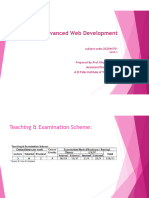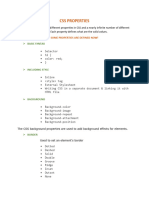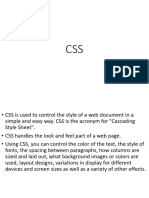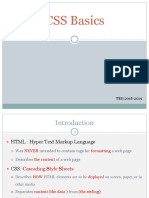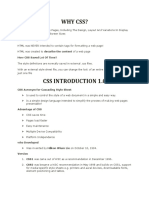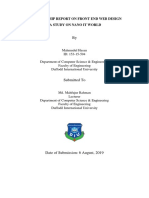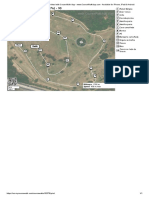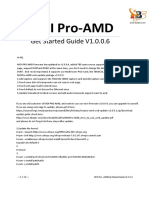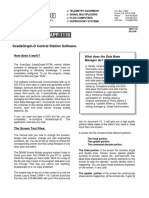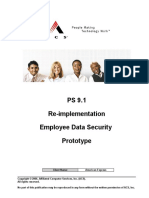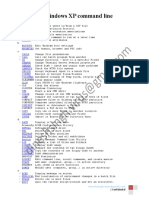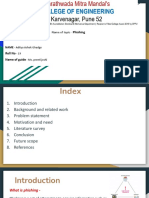Internet Development
04 Introduction to CSS
Dr. Fatma Sakr
CSS Sheet
Style sheet contain one or more CSS Rules
Selector
body {
font-family: Tahoma, Arial, sans-serif;
color: black;
background: white;
margin: 8px; }
Property Value
CSS Sheet
CSS Pseudo Selectors
: hover selector is used to select elements when you mouse over them.
hover - Apply rule when mouse is over element (e.g. tooltip)
p:hover, a:hover {
background-color: yellow;
}
a:link , a: visited - Apply rule when link has been visited or not visited (link)
a:visited { a:link {
color: green; color: blue;
} }
CSS Properties
Control many style properties of an element:
● Coloring
● Size
● Position
● Visibility
● Many more: e.g.
p: { text-decoration: line-through;
}
● Also used in animation
CSS Properties: Coloring
Must ultimately turn into red, green, and blue intensities between 0 and 255:
● Predefined names: red, blue, green, white, etc. (140 standard names)
● 8-bit hexadecimal numbers for red, green, blue: #ff0000
● 0-255 decimal intensities: rgb(255,255,0)
R G B
● Percentage intensities: rgb(80%,80%,100%)
R G B
Example: h1: { color: red; }
Color - Properties: color &
background_color
8
CSS Box Sizing
The CSS box-sizing property allows us to include
the padding and border in an element's total width
and height.
If you set box-sizing: border-box; on an element,
padding and border are included in the width and
height:
SET 372 – Internet Development 12-Mar-
24
9
CSS Box Sizing
.div1 {
width: 300px;
height: 100px;
border: 1px solid blue;
box-sizing: border-box;
}
.div2 {
width: 300px;
height: 100px;
padding: 50px;
border: 1px solid red;
box-sizing: border-box;
}
SET 372 – Internet Development 12-Mar-
24
Without the CSS box- 10
sizing Property
By default, the width and height of an element is calculated like this:
width + padding + border = actual width of an element
height + padding + border = actual height of an element
This means: When you set the width/height of an element, the element
often appears bigger than you have set (because the element's border and
padding are added to the element's specified width/height).
The following illustration shows two <div> elements with the same
specified width and height:
SET 372 – Internet Development 12-Mar-
24
Without the CSS box- 11
sizing Property
.div1 {
width: 300px;
height: 100px;
border: 1px solid blue;
}
.div2 {
width: 300px;
height: 100px;
padding: 50px;
border: 1px solid red;
}
SET 372 – Internet Development 12-Mar-
24
CSS Box Model
The CSS box model is essentially a box that wraps around every
HTML element. It consists of: content, padding, borders and
margins.
CSS distance units
Size Properties : Element, pad,
margin, border
Width
Override element defaults border-bottom-color
height
border-bottom-style
padding-top border-bottom-width
padding-right border-left-color
border-left-style
padding-bottom border-left-width
padding-left border-right-color
border-right-style
border-right-width etc.
margin-top
i.e.
margin-right
margin-bottom p {
border: 5px solid red;
margin-left }
position property
position: static; (default) - Position in document flow
position: relative; Position relative to default position via
top, right, bottom, and left properties
position: fixed; Position to a fixed location on the screen via top,
right, bottom, and left properties
position: absolute; Position relative to ancestor absolute element
via top, right, bottom, and left properties
Fixed position (0,0) is top left corner
Element visibility control
properties
display: none; - Element is not displayed and takes no space in
layout.
display: inline; - Element is treated as an inline element.
display: block; - Element is treated as a block element.
display: flex; - Element is treated as a flex container.
display: grid; - Element is treated as a grid container.
visibility: hidden; - Element is hidden but space still
allocated.
visibility: visible; - Element is normally displayed
17
layout modes
There are multiple layout modes:
o Block, for sections in a webpage
o Inline, for text
o Table, for two-dimensional table data
o Positioned, for explicit position of an element
o Flexbox Layout
o Grid Layout
SET 372 – Internet Development 12-Mar-
24
18
To start using the Flexbox model, you need to first define a flex
container.
The element above represents a flex container (the blue area) with
three flex items.
The flex container becomes flexible by setting the display
property to flex:
Example
.flex-container {
display: flex;
}
SET 372 – Internet Development 12-Mar-
24
Flexbox and Grid layout
display: flex; (Flexbox)
display: grid; (Grid) newer layout method
○ Items flex to fill additional space and shrink to fit into
smaller spaces.
○ Useful for web app layout:
■ Divide up the available space equally among a
bunch of elements
■ Align of different sizes easily
■ Key to handling different window and display sizes
● Flexbox - Layout one dimension (row or column) of elements
● Grid - Layout in two dimensions (rows and columns) of elements
20
The flex-direction Property
The flex-direction property defines in which direction
the container wants to stack the flex items.
SET 372 – Internet Development 12-Mar-
24
The column-reverse 21
Property
The column-reverse value stacks the flex items vertically (but from bottom
to top)
SET 372 – Internet Development 12-Mar-
24
Some other CSS issues - span 22
A <span> element which is used to color a part of a text
The <span> tag is an inline container used to mark up a part
of a text, or a part of a document.
The <span> tag is easily styled by CSS or manipulated with
JavaScript using the class or id attribute.
The <span> tag is much like the <div> element, but <div> is
a block-level element and <span> is an inline element.
SET 372 – Internet Development 12-Mar-
24
Some other CSS issues
Inheritance
○ Some properties (e.g. font-size) are inherited from parent elements
○ Others (border, background) are not inherited.
Multiple rule matches
○ General idea: most specific rule wins
<span>Text1</span>
span.test { color: green }
<span class="test"> Text2 </span>
span { color: red }
Adding Styles to HTML
Separate style sheet (best
<head> way)
<link rel="stylesheet" type="text/css" href="myStyles.css"
/>
<style type="text/css">
body {
font-family: Tahoma, Arial, sans-serif;
}
</style>
Page-specific styles
</head>
<body>
<div style="padding:2px; ... ">
</body>
Element-specific styles
CSS: HTML
CSS HTML
Example Output
27
CSS Media Queries
Media queries are a popular technique for delivering a tailored style sheet to
different devices. To demonstrate a simple example, we can change the
background color for different devices:
SET 372 – Internet Development 12-Mar-
24
CSS Media Queries 28
- Example
/* Set the background color of body to tan */
body {
background-color: tan;
}
/* On screens that are 992px or less, set the background color to blue
*/
@media screen and (max-width: 992px) {
body {
background-color: blue;
}
}
/* On screens that are 600px or less, set the background color to olive
*/
@media screen and (max-width: 600px) {
body {
background-color: olive;
}
}
SET 372 – Internet Development 12-Mar-
24
Output 1: Media Screen 29
blue
SET 372 – Internet Development 12-Mar-
24
30
Output 2: Media Screen tan
SET 372 – Internet Development 12-Mar-
24
Output 3: Media Screen 31
Olive
SET 372 – Internet Development 12-Mar-
24
CSS in the real world
CSS preprocessors (e.g. less) are commonly used
○ Add variable and functions to help in maintaining large
collections of style sheets
○ Apply scoping using the naming conventions
Composition is a problem
○ It can be really hard to figure out what rule from which
style sheet is messing things up





